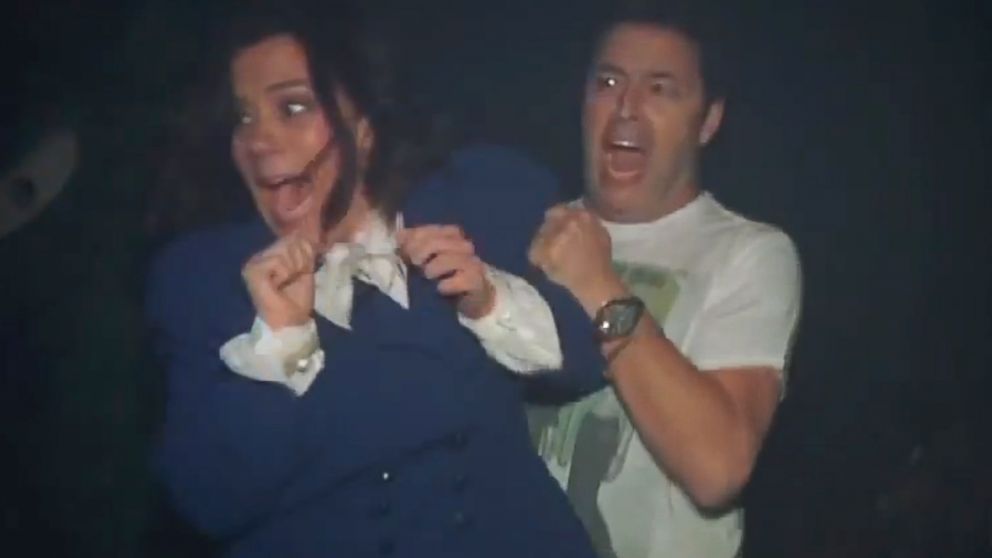Why Fear Makes Us Scream, Pee Our Pants and Enjoy It
Terror and ecstasy, after all, are not very far apart.

Oct. 29, 2013— -- Amy Rhodes, senior writer for the popular syndicated "Ellen DeGeneres Show," got a scary assignment from her boss: She had to tour a Halloween house of horrors with executive producer Andy Lassner for protection.
Rhodes scolds Lassner for using her as a block as they dodge blood-stained zombies and jumping bogey men in the haunted halls of a themed prison.
"Why are you hiding behind me?" she screams. "You're a man, be a man, be a man!"
The hilarious video of the pair went viral with more than 3 million viewers on YouTube, testament to the age-old maxim that people like to be afraid – very afraid.
At the end of the tour, the cowardly Lassner asks breathlessly, "Why do people pay for this?"
As Halloween approaches this week, businesses are capitalizing on the psychology of fear. Last year. Americans spent more than $8 billion on scary costumes, haunted houses and fright fests, according to the National Retail Foundation.
Terror and ecstasy, after all, are not far apart emotionally.
Why do we watch stressful TV like "Breaking Bad?"
Fear arouses a cocktail of chemistry in the cerebral cortex -- the part of the brain that controls memory, perception and consciousness.
Breathing steps up, the heart races, muscles tighten. The fight or flight mechanism kicks in -- even if the danger isn't real.
"You get a rush of dopamine, which is typically pleasurable," said Frank Farley, former president of the American Psychological Association and professor at Temple University. "You get it in risk-taking, like stepping off to do skydiving or something. There is going to be this rush."
"Being scared is exhilarating and funny at the same time. It's fun to share that with your best friends." -- Debbie D.
The response is initiated in the brain's hypothalamus which activates the sympathetic nervous system and the adrenal-cortical system which pours 30 different hormones into the blood stream. The body becomes tense and alert.
From Halloween to horror stories, why we love to be afraid.
Reactions include increase in blood pressure, dilated pupils, constriction of the veins of the skin, causing the chilly sensation associated with fear. Blood sugar levels rise and the body shuts down its digestive and immune system.
Once fear passes, the body releases the hormone cortisol to calm itself back down to normal.
Debbie D., a saleswoman who grew up in New England, remembers the combination of fear and laughter that accompanied an incident at a pajama party in her rambling 18th century home.
The 11-year-old girls were huddled together in sleeping bags, telling ghost stories.
WATCH FROM 'WORLD NEWS': THE BUSINESS OF SPOOKINESS
"The old walls were thin and we all stopped talking and were finally dozing off," said the 61-year-old, who now lives in California. "I remember hearing footsteps above us and one of the girls asked what that sound was. You could hear every sound in that old house, including the mice running around."
Debbie had anticipated a scare from her older sister, who had slipped down an old stairwell and was scratching the door with a curtain rod.
"I particularly liked getting spooked because it made us laugh more," she said. "Everyone joined in with their explanation of what the creepy sounds could be and slowly, but surely, terror and excitement crept back into the room."
Suddenly, her sister threw open the door and "roared awful screeches" as she shone a flashlight in the young girls' eyes.
"Being scared is exhilarating and funny at the same time," said Debbie. "It's fun to share that with your best friends."
But for some, fear brings only anxiety. One 11-year-old at the party peed her sleeping bag and another cried so hard, she had to go home.




